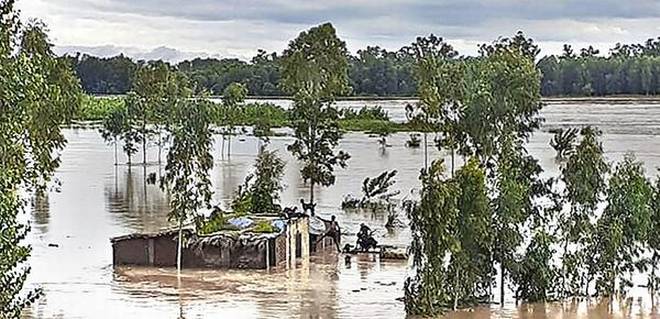
CHANDIGARH: Punjab, ‘the land of the five rivers’, witnessed one of the most devastating floods in forty years. Six districts, Jalandhar, Kapurthala, Roopnagar, Ludhiana, Moga and Ferozepur, were hit worst by the floods which were triggered by the incessant rainfall received by various states in Northern India. As a direct consequence of the incessant rainfall, excess water was released into the Sutlej and Swan rivers by the Bhakra Beas Management Board (BBMB). This created breaches at various points in the river and its tributaries. As many as 14 districts were put on flood alert, 13,635 people were affected and 5,973 persons from approximately 300 villages were evacuated. “It was an extreme rainfall event, and these events are on the rise over the last few decades,” said Kuldeep Srivastava, Head of Regional Weather Forecasting Centre (RWFC), Indian Meteorological Department (IMD), New Delhi. The death toll as recorded in the third week of August showed that more than 40 people had lost their lives in the flood effected states of north India with eight of these incidents recorded in Punjab. The flood inflicted some substantial losses to the state: 1.72 lakh acres of farms were destroyed; 1,868 houses damaged; 4,228 animals died.
After the outbreak of the disaster, Amarinder Singh, Chief Minister of Punjab, announced fund dispersal of Rs 100 crore for emergency relief and rehabilitation measures in affected regions immediately and deputed four ministers of the Punjab government to look over the relief operations in the flood-affected Ropar, Jalandhar and Kapurthala districts and directed authorities to commence the process of restoration of power supply in the affected areas.
The state government had brought in the Indian army to aid the relief work along with the NDRF and other state relief forces. NGOs like Khalsa Aid International also played a crucial role in containing the disaster. Punjab CM also announced on August 26 that additional relief measures were to be enforced across the affected areas for rehabilitation of the flood victims.
On August 28, the CM announced that the state incurred a total damage in infrastructure of about Rs 2000 crore from the floods. Further, a relief amount of Rs 475 crore has been set aside for relief work in the six primarily affected districts. GS Kangar, Revenue Minister, Punjab Government said that the government has already released as of now Rs 4.50 crore to the six districts. The amount has been released in the ratio of Rs 1 crore each for Jalandhar, Kapurthala and Roopnagar, while Rs 50 lakh each for Ludhiana, Moga and Ferozepur. Earlier, Rs 2.10 crore in the proportion of Rs 35 lakh to each of these districts was provided to commence the relief and rescue operations, Kangar said.
The amount released is primarily for short-term management tasks ranging from provision of fodder for cattle, disposal of dead animals, transit accommodation, tents, tarpaulins, temporary toilets, medicines, provision of dry ration, drinking water, milk powder and recovery of debris from river banks/water. Sukhbinder Singh Sarkaria, Water Resources Minister said that 12 breaches in the rivers have been successfully plugged so far and the work of plugging remaining breaches was on at war footing. The government is also working to plug other breaches at river banks in order to contain the overflow of the rivers. In order to avert such disasters in the future, Punjab government announced, on August 24, a major plan to canalise all rivers of the state.

